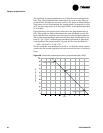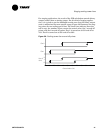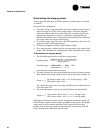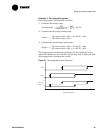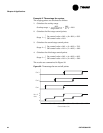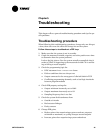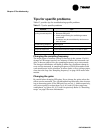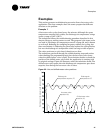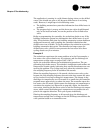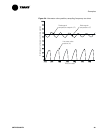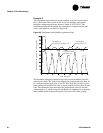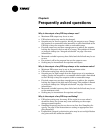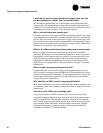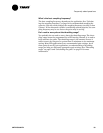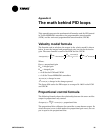
®
Chapter 5 Troubleshooting
48 CNT-APG002-EN
The application is running in a cold climate during winter, so the chilled-
water valve should not open at all (because chilled water is not being
used). However, it might open in the following cases:
• The building automation system has information that chilled water is
available.
• The program logic is wrong, and the hot-water valve should depend
only on the heat/cool mode, not on the position of the chilled-water
valve.
Before reprogramming the controller, the technician checks to see if the
building automation system has information that chilled water is avail-
able. The technician finds that the building automation system had been
configured incorrectly and is sending the controller information that
chilled water was available. To fix the problem, the technician resets the
building automation data point. The controller no longer opens the
chilled-water valve, which in turn prevents the hot-water valve from
cycling closed every few minutes.
Example 2
The technician experiences the same problem as in the first example: a
hot-water valve cycles closed every few minutes, and the discharge-air
temperature swings across a range of 10°F (5.6°C).
Again, the technician follows the troubleshooting procedure. The pro-
gramming logic looks correct. The mixed air temperature and outdoor air
temperature remain steady, indicating that outside disturbances are not
causing the problem. The cycling stops only when the technician slows
the sampling frequency from 10 seconds to 30 seconds.
When the sampling frequency is 10 seconds, the hot-water valve cycles
because the fast sampling frequency does not take into account the natu-
ral lag involved in trying to change air temperature. The change in the
discharge-air temperature over 10 seconds is so small that the controller
responds more aggressively to reduce the error. The controller opens the
hot-water valve too much, which causes the discharge-air temperature to
overshoot the setpoint (see Figure 34 on page 49). Again, the controller
over-reacts, shutting the hot-water valve to cool the discharge-air temper-
ature, which causes the discharge-air temperature to overshoot the set-
point in the opposite direction. This cycle repeats indefinitely.
Slowing the sampling frequency to 30 seconds gives the discharge-air
temperature enough time to change so that the PID loop can calculate the
valve position based on a reasonable error.



